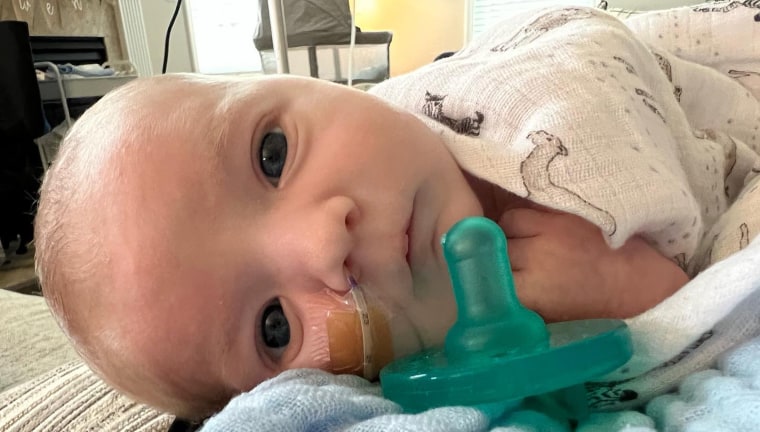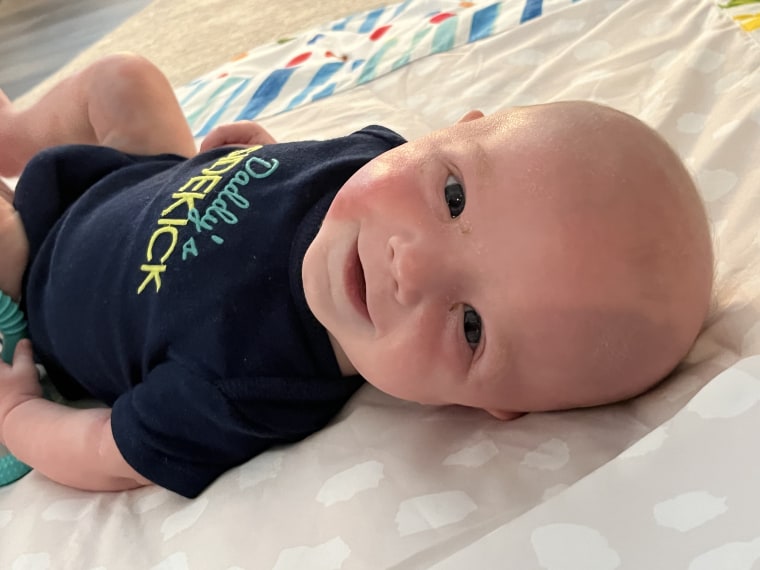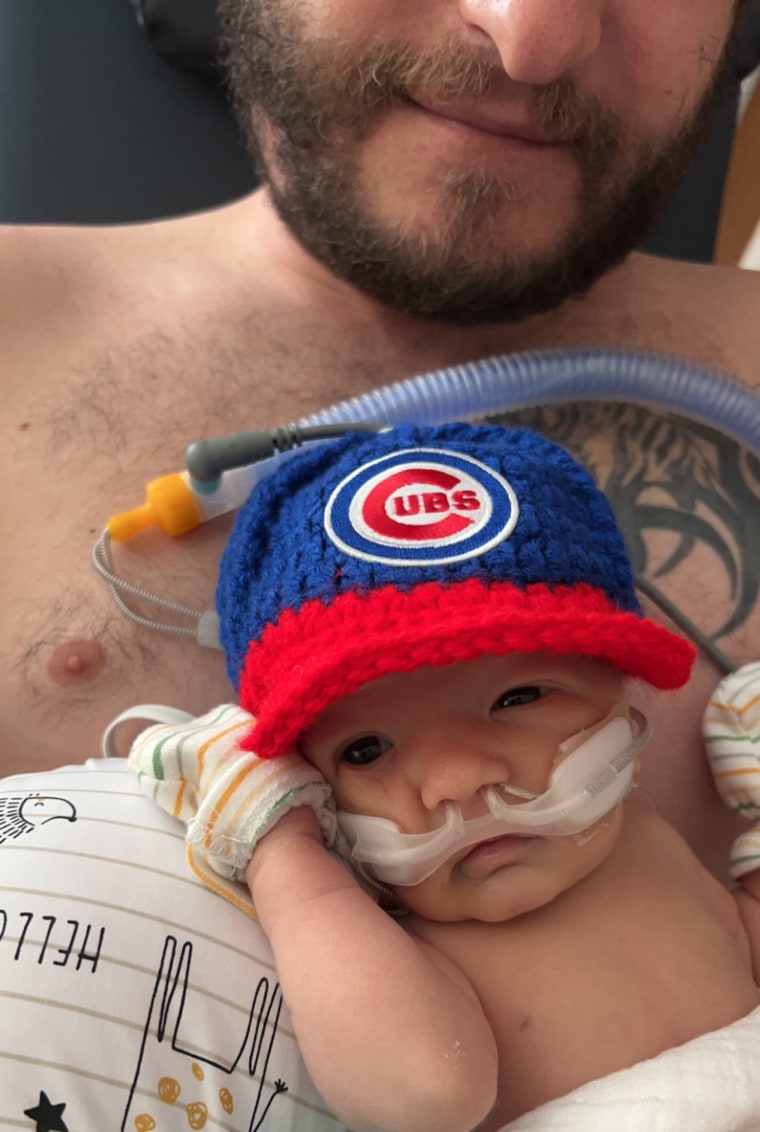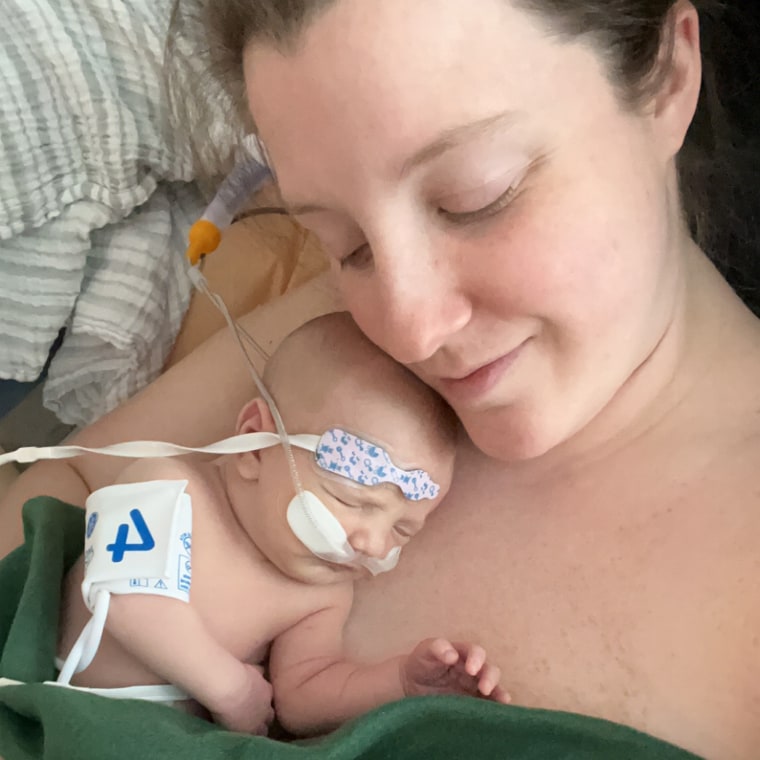Owen Monroe was just days old when his parents learned that his congenital heart defect was so severe that it could not be treated with the standard surgeries. But using a procedure that had only been performed successfully on pigs, surgeons transplanted parts of a donor heart into Owen’s heart, saving his life.
The groundbreaking procedure is being hailed as a game changer in the field of pediatric heart surgery and provides hope for thousands of babies with congenital heart defects.

Today, Owen Monroe is a healthy 5-month-old baby meeting all the major developmental milestones: He’s holding his head up, making eye contact and playing with his toys. But this reality seemed nearly impossible when he was born earlier this year.
Tayler and Nick Monroe first got the warning signs that something was wrong about 16 weeks into the pregnancy. A routine ultrasound showed a problem with Owen’s blood flow and that he wasn't growing properly, his mother, Tayler Monroe, told TODAY. Another ultrasound at 20 weeks revealed that Owen had a life-threatening birth defect in his heart called truncus arteriosus.
Truncus arteriosus is a rare congenital heart condition that occurs when the blood vessel coming out of the heart fails to develop properly in utero, according to the U.S. Centers for Disease Control and Prevention.

A healthy heart normally has two arteries coming out of the heart: one that goes to the body and provides oxygenated blood to the body (aorta) and one that goes to the lungs to get the oxygen (pulmonary artery), Dr. Joe Turek, chief of pediatric cardiac surgery at Duke University and Owen’s surgeon, told TODAY.
“Instead of having two arteries that come out of the heart … (Owen) only had one main artery and valve that came out of the heart,” said Turek. Additionally, Owen Monroe's one artery had a valve (which controls the blood flow) that was leaking.
“It’s not something anybody wants to hear,” Owen’s father, Nick Monroe, told TODAY.
Infants with truncus arteriosus must have surgery — usually within the first few months of life — to repair the heart and blood vessels, according to the CDC. If left untreated, the condition can be fatal, Turek added.
Owen Monroe was born on April 5, 2022. The next day, Nick and Tayler Monroe received more bad news. A post-birth test revealed that leak in Owen's valve was so severe that the original surgery doctors were planning wasn't going to work.
No time for a heart transplant
“Typically we can repair these defects if that valve is good. Unfortunately, in Owens’ case, his valve … was really abnormal, and we wouldn’t be able to fix it,” said Turek, adding that this is uncommon for truncus arteriosus patients.
As a result, Owen Monroe would need two new arteries and two new valves — “basically, the top half of his heart needed to be replaced,” said Turek.
Surgeons typically create replacement arteries and valves from frozen, preserved cadaver tissue, but these don't grow because the tissue is not living, so an infant or young child will outgrow them, Turek explained.
“We get the child as far as we can with that size of a valve and artery and then we bring them back when it needs to be replaced,” he said, adding that this requires going through the breastbone and performing open-heart surgery each time.

“We were faced with a dilemma. If we used the standard, traditional way of doing things … this would require successive, invasive operations, with each operation carrying a higher and higher risk,” said Turek. “I felt like putting two non-living valves … was really going to destine (Owen) to a series of operations within his childhood.”
The next option was a heart transplant, said Tayler Monroe, but finding a full, viable heart that was a match would take too long. “They said it takes four to six months to get a newborn heart, and we don’t think we have that time,” she recalled. “He was going to go into heart failure pretty soon."
Finally, Turek proposed another technique he and his colleagues had been researching: a partial heart transplant. “This is something that’s been talked about for a while … how (to) replace a portion of a heart and allow that to then act as if it’s native in that patient, so … it’s going to grow along with the rest of the heart,” said Turek.

The catch? The procedure had never been performed on a human before.
“They said, 'It’s done successfully on pig hearts, and I was like OK, tell me more. … How are the pigs doing?'" Tayler Monroe recalled. “(They said) all success with the pigs, no issues. They were growing, they were thriving. ... I said, ‘Is this our only option?’ And they said yes.”
A first-of-its-kind procedure
"Logistically, it’s been very difficult to try to figure out how to make this work and to have the right child and the right family to be able to try it for the first time,” said Turek. But given the severity of Owen’s condition and the possibility of a better outcome with the living tissue from a partial heart transplant, it seemed like the right next step, he added.
The final decision was up to Owen Monroe’s parents. “I said, 'Well, whatever you have to do to save our son, please do it,” Tayler Monroe said.
Although finding a donor for the partial heart transplant would take less time than for a total transplant, every day of waiting was a struggle. “You’re sort of just sitting there, watching your child suffer … and there’s nothing you can do,” Nick Monroe said.

On April 22, doctors told Owen's parents that they had found a match. At 17 days old and weighing just over 5 pounds, Owen became the first partial heart transplant recipient ever.
“The operation went really well,” said Turek. “I’ve seen (Owen) back a few times in the clinic, and he looks fantastic. … Both valves are growing along with him at the appropriate rate and the valves work perfectly.”
Owen still has to take anti-rejection medications to ensure his immune system does not attack the transplanted parts of his heart, but there is a chance he may be able to wean off these in the future. “Right now, I think he can really live a very normal life,” Turek said.
Revolutionizing heart surgery in children
“I believe that this operation solves the major problem we have in pediatric heart surgery, which is children grow, but unfortunately, their valves don’t grow with them when you replace them,” said Turek. “It will be really revolutionary in the sense that … we can do an operation that could potentially last a child like Owen decades, maybe a lifetime.”

Although more research and clinical trials are needed, Turek has hope that pediatric heart surgeons will embrace this technique and it will become more popular in the coming years.
"I think this can revolutionize heart surgery in children. … If this became standard of care, we would have a lot of happier children running around with fewer operations and quicker returns to what kids should be doing," said Turek.
Another potential benefit of this procedure is that it can allow surgeons to use donated hearts that are not acceptable for full transplantation but still have healthy parts.
"We have a large number of hearts out there that currently go unused. … We could tap into that and use these as living valves and living arteries to help out children like Owen," said Turek.

Conversations are ongoing with United Network for Organ Sharing (which manages the U.S. organ transplant system) to figure out how to “bring this to the point where it’s a common clinical operation,” said Turek.
Tayler Monroe added that the experience has been "eye-opening. ... If this can help save even just one more child, it’s worth it, but the thought that it could save hundreds or thousands, it’s unbelievable."